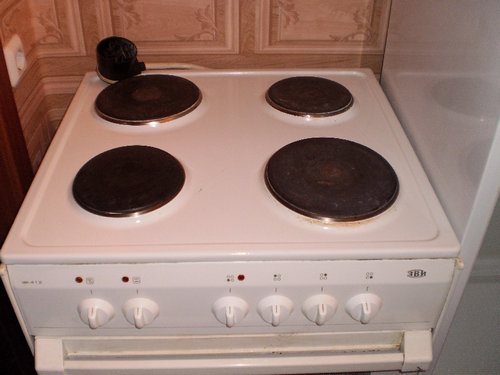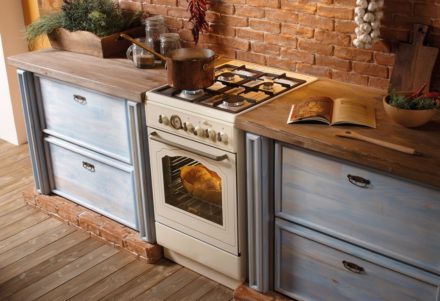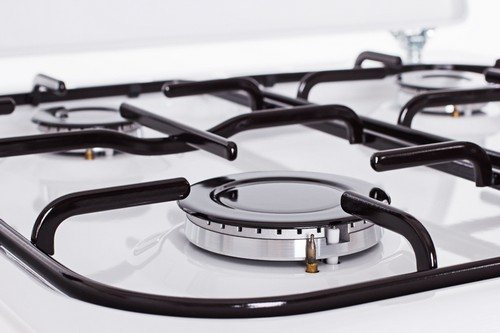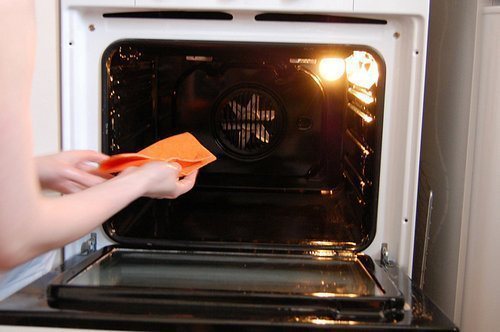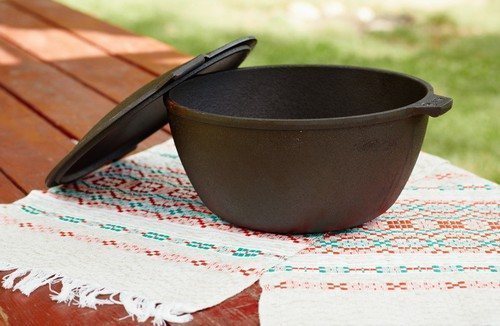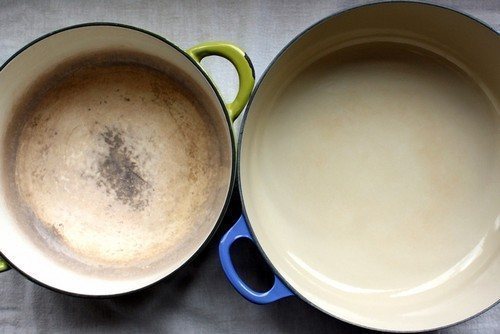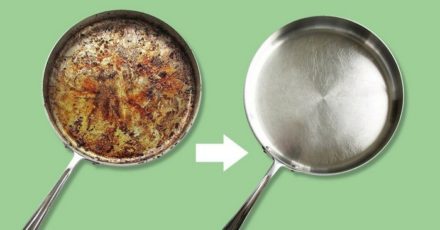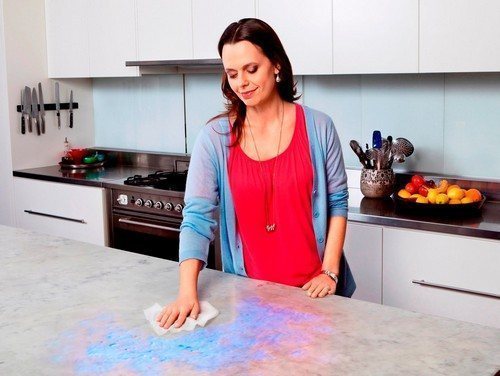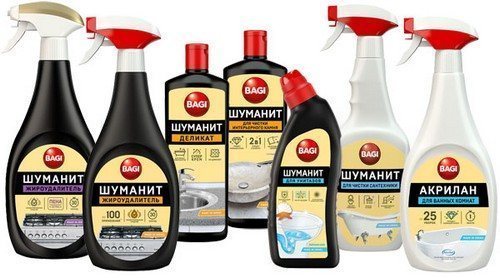Over time, burnt and ingrained plaque accumulates on the grill. It is not easy to return the rods to cleanliness, but there are many methods of dealing with contamination. To clean the grate of a gas stove without damaging the surface, determine what material it is made of. And for effective and quick cleaning, choose the appropriate product depending on the degree of contamination.
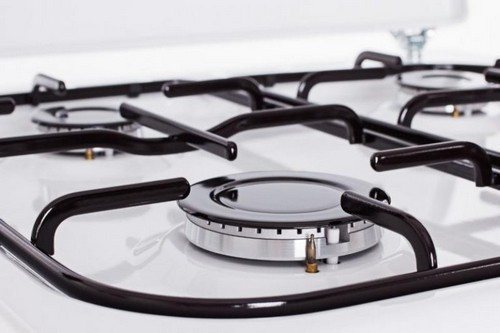
- Types of gas stove grates
- Made of cast iron
- Enameled metal
- Stainless steel
- Causes of grate contamination
- Preparing to clean the grate on a gas stove
- Soaking the grate before cleaning
- Universal folk remedies for cleaning gas stove grates
- Soda
- Steam
- Boiling water
- Mustard
- Vinegar
- Soap solution
- Melamine sponge
- Ammonia
- Laundry soap and office glue
- Silicate glue and washing powder
- Dishwasher
- Specialized products for cleaning gas stove grates
- Mechanical cleaning of the grille
- Calcination
- Cleaning details depending on the grate material
- Cast iron
- Enameled steel
- Stainless steel
- How to prevent pollution
- Additional Tips
Types of gas stove grates
The material is important when choosing a grate, since it is subject to double load, exposure to high temperatures from below, and the weight of the dishes from above.
The choice of cleaning method directly depends on the material of this part of the gas stove.
Made of cast iron
Cast iron grates are considered the most reliable and durable, since it is a metal that can withstand prolonged heating and heavy loads better than others, and does not deform or burn out.
Cast iron rods can be identified by their impressive weight.
Enameled metal
Enameled metal is suitable for the grate when the gas stove is used rarely and not systematically. Despite its attractive appearance, enamel has two significant drawbacks: it burns out quickly and is susceptible to chipping and damage.
Parts made of enameled steel are characterized by a glossy sheen of the coating.
Stainless steel
Stainless steel rods are cheaper, lighter and more varied in shape than cast iron, but are inferior to them in strength and service life. The main disadvantage of stainless steel gratings is gradual deformation under the influence of high temperatures. After some time, such products lose their appearance.
Stainless steel differs from cast iron and enamel in its light color.
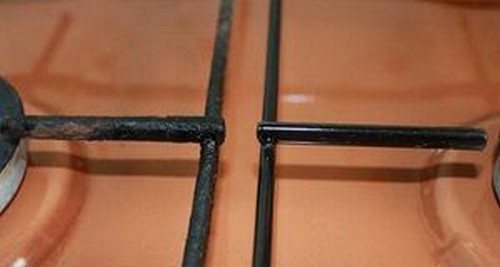
Causes of grate contamination
Before you can understand how to remove stains, you need to know how they form. During the cooking process, food and fat residues fall on the surface of the rods, burn to them and, over time, eat into the coating. The next time you use it, a new portion of fat gets on the formed plaque. Layer by layer, soot builds up and thickens, the fire evaporates all the moisture from the inside, forming solid scale. Such ingrained greasy deposits are difficult to remove.
Preparing to clean the grate on a gas stove
Before you begin cleaning, prepare the grate and provide your work area with the necessary supplies.
Step 1. Make sure you have on hand:
- spacious container (basin, bathtub, sink, etc.);
- hard (metal) brush;
- foam sponge;
- dry cloth.
Step 2. If the grate is removable, remove it from the stove. If there are plastic or rubber elements, they should be removed.
Step 3. Cover the work surface with newspapers or foil so as not to be damaged by crumbling soot particles.
Step 4. Use durable rubber gloves.
Soaking the grate before cleaning
Initial soaking greatly facilitates the removal of old plaque. Dissolve a sufficient amount of dishwashing liquid in a bowl of hot water and leave the product for several hours. Instead of detergent, baking soda is suitable; alkali will break down plaque well.
Soaking is not suitable for cast iron, since prolonged contact with water of this metal leads to rust. But enameled or stainless steel rods can be left in water overnight.
After the fat has soaked, the main stage follows - cleaning the dirt with a brush using folk or specialized products.
Universal folk remedies for cleaning gas stove grates
Traditional methods have several advantages. They are always available in a store or pharmacy, are much cheaper than specialized ones, and, moreover, are not toxic to the body.
Below are effective, proven folk ways to clean the grate of a gas stove.
Soda
Wipe the coating with a damp sponge. Mix baking soda and water in a bowl until a paste forms. Cover the surface of the product thickly with the mixture and leave for 2-3 hours. After the soda dissolves the carbon deposits, use a stiff brush to remove any remaining dirt and rinse with warm water. Repeat the procedure if necessary.
For greater effectiveness, it is recommended to add crushed laundry soap or hydrogen peroxide to the mixture.
Steam
By treating the coating with a steam cleaner, you can clean the rods without using aggressive substances. Hot steam softens the layer of soot and fat, which is subsequently easily removed with a brush. The method is especially convenient for non-removable products.
If there is no steam generator, place a baking sheet on the bottom of the preheated oven, pour water into it and boil. Place the plate parts on top and leave for an hour. The steam from a boiling liquid will act in the same way as steamer.
Boiling water
To get rid of fat deposits using boiling water, place the stove parts in a deep baking tray, add water to completely cover them, and place in a preheated oven. The water must boil for some time so that the layer of soot comes away from the metal.
Mustard
It is not recommended to use ready-made dressing to break down carbon deposits. Dilute dry mustard powder with hot water to a paste consistency. Coat the coating with the resulting mixture, leave for 2-3 hours, then remove any remaining plaque with a stiff-bristled brush. Without damaging the metal, mustard will dissolve fatty deposits, which can be easily removed in the future.
Vinegar
Dilute vinegar essence with water 1:3. Place a wire rack on a baking sheet, pour in the resulting solution and leave for 3 hours. If the layer of greasy deposits is too thick, it is recommended to soak the product overnight, and be sure to take it out onto the balcony or outside.
Please note that when using vinegar, you must constantly ventilate the room, otherwise the caustic fumes may affect the respiratory tract.
Soap solution
The most common, simple and affordable method, but not entirely effective against old plaque, is using a soap solution. It is recommended to combine it with other traditional methods to successfully clean the coating.
Stir a bar of crushed laundry soap or a strong detergent into hot water. The solution should be strong. Place the grate in the resulting liquid and leave to soak overnight, clean with a stiff brush the next morning.
Melamine sponge
The melamine sponge differs in price compared to other folk remedies, but is not inferior in efficiency and ease of use. Excellent for permanent grilles.
Wet the sponge, gently wring it out, and, pressing it to the surface, rub area by area. If the sponge becomes clogged with grease, rinse and continue cleaning. Finally, wipe the cleaned parts with a damp cloth.
Melamine is used without the use of additional detergents, as it will react with them.
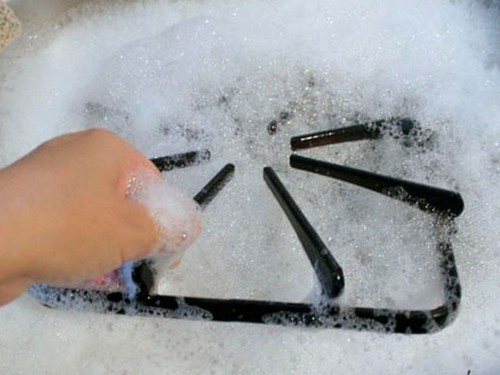
Ammonia
One of the most effective folk methods is cleansing with ammonia. Place all parts in thick plastic bags, fill with ammonia and tie securely. Leave for several hours, then from the outside, sliding along the surface of the cellophane, wipe the rods. The carbon deposits will come off easily.
Laundry soap and office glue
The next method is not entirely ordinary, but is not inferior in effectiveness to other traditional methods. Stationery glue contains a lot of soda, hence its useful qualities in the fight against soot and grease.
In an iron basin, combine crushed laundry soap and office glue (150 ml), mix thoroughly and put on fire.After boiling, dip the rods into the solution and boil for an hour. After the time has passed, quickly transfer the product to clean warm water and wash off any remaining plaque.
Silicate glue and washing powder
In a glass of warm water, dissolve 50 ml of silicate glue, 3 tbsp. soda and 1 tsp. washing powder, mix to a smooth paste and apply to the coating. Wrap in a plastic garbage bag and leave for an hour. Silicate glue reacts with soda, corroding carbon deposits, and with the help of powder it is easier to remove remaining dirt.
Dishwasher
This method is ideal for enameled steel. Load the grate into the machine, add double the amount of detergent and turn on the PMM in normal mode. It is advisable to use soda tablets. After finishing the program, dry the cooker parts.
Specialized products for cleaning gas stove grates
Specialized products are characterized by an aggressive chemical composition that quickly breaks down contaminants, but at the same time is toxic to the human body. Therefore, do not work without gloves and keep the kitchen always ventilated.
Special products for combating burnt fat deposits are divided into 3 groups.
- Gel (cream). Such grease removers quickly combat carbon deposits while being gentle on the coating. Suitable for all types of surfaces.
- Spray. The most convenient form of cleaner to use. May contain substances hazardous to cast iron or enamel, so you should read the instructions before purchasing.
- Powder. Similar to home methods, specialized powders are diluted with water to a paste and applied in a thick layer to the coating.
Mechanical cleaning of the grille
Stubborn plaque can be removed by mechanical cleaning. This method is only suitable for stainless steel; if you try to scrape cast iron or enamel with a metal brush, the coating may break off along with carbon deposits.
Wet the rods, scrape off the carbon deposits with a stiff brush, periodically rinsing the brush to remove accumulated grease.
There is one proven folk trick. Buy a medium-hard metal brush attachment for a drill from the store, insert it into the tool and walk along the rods. Cleaning them this way will be much faster and more efficient.
Calcination
This simple and economical method is ideal for cast iron, as it does not damage the top layer of coating. The disadvantage of this method is the difficulty of carrying it out in an apartment.
Heat the grate over an open fire, turning it over occasionally, until all the plaque falls off and burns out. Then rinse and leave to cool naturally.
Cleaning details depending on the grate material
All methods are effective in the fight against stubborn grease and soot, but not all are universal for different surfaces.
Cast iron
It is not advisable to subject a cast iron product to rough processing and cannot be washed in the dishwasher. Harsh mechanical impact will damage the coating, and when washed in PMM, under the influence of hot steam, the top layer of metal is destroyed, which will soon lead to corrosion.
The soaking method is also not suitable for cast iron. The optimal method of cleansing is calcination.
Enameled steel
Enamel does not tolerate rough scraping with metal brushes, a knife or other hard objects. Such methods damage the surface, causing chips and scratches.All other methods can be used safely, but the most suitable is washing in the dishwasher.
Stainless steel
Stainless steel products are the most unpretentious; they can be safely cleaned with caustic detergents, scrubbed with a wire brush, and soaked. Even if scratches remain after cleaning, they will not affect the further operation and service life of the product.
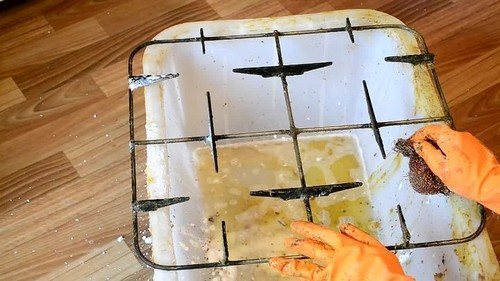
How to prevent pollution
To prevent stubborn greasy deposits from appearing on the grate, it is enough to wipe the bars with a sponge and detergent after each use of the stove. Periodically wash the product under the tap with soapy water.
Besides, there is one secret. Apply a special protective compound to a clean surface. Mix baking soda and office glue into a thick paste, add a handful of laundry detergent and apply to the surface. After drying, the mixture will become transparent, and the next time you wash it, sliding over the surface, it will be easily washed off with water, easily removing dirt.
Additional Tips
- a sharp temperature change is destructive to metal, so you should not soak a part that has not cooled down in cold water;
- when using traditional methods, mix the substances with liquid until a thick paste is formed;
- Choose specialized store products labeled “Anti-grease”;
- car engine cleaner reduces the service life of the rods by destroying the coating;
- If there is a pungent odor coming from the cleaning substance, be sure to ventilate the room;
- Dry the cleaned grate and only then use it.


